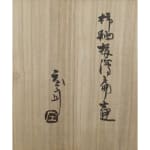Hamada Shōji (1895–1978)
Flat Vase with Iron Rust Glaze over Wax Resist
With a box signed by the artist
L12.5 x W20.3 x H24.6 cm
L12.5 x W20.3 x H24.6 cm
Further images
Exhibitions
Hamada Shoji to Kawai Kanjiro. Tokyo: Nihonbashi Mitsukoshi, 2006.
This distinctive features of the Mingei ceramist Hamada Shoji, a Living National Treasure, are extensively assembled in this henko, or flat vase.
The kakiyu, or iron rust glaze, used by Hamada refers to the glaze made from the reddish pigment of the Ashinuma rock originated in Ashinuma, Mashiko Town. A traditional glaze for making Mashiko-yaki ware, kakiyu appears a deep brown color after firing. The nukie, or wax resist, technique, involves laying water-repellent paraffin wax over the designed motif to prevent the glaze going onto the design. The motifs of the present work are created by the application of iron pigment, on top of which transparent glaze, paraffin wax and kakiyu are applied one layer after another. The kakiyu is laid thinner around the boundary of the motifs, as well as the vase’s mouth and shoulders, and where it meets the transparent glaze naturally appear black, manifesting an effortless beauty.
Henko usually refers to flat jars rather than ones of round shape, and are typically exemplified by the Joseon dynasty henko. The Mingei artists Hamada Shoji and Kawai Kanjiro are known to favor the form of these henko. There are numerous henko by Hamada survive to this day. According to the Nihonbashi Mitsukoshi exhibition Hamada Shoji and Kawai Kanjiro catalog, the present work is produced in 1959.
Hamada Shoji (ceramist; 1895–1978)
Kanagawa-born ceramist. Master in the mingei ceramic field. Contributed to the development of Mashiko-yaki. Designated as a holder of Important Intangible Cultural Property, Mingei ceramics in 1955. Received the Order of Culture.
The kakiyu, or iron rust glaze, used by Hamada refers to the glaze made from the reddish pigment of the Ashinuma rock originated in Ashinuma, Mashiko Town. A traditional glaze for making Mashiko-yaki ware, kakiyu appears a deep brown color after firing. The nukie, or wax resist, technique, involves laying water-repellent paraffin wax over the designed motif to prevent the glaze going onto the design. The motifs of the present work are created by the application of iron pigment, on top of which transparent glaze, paraffin wax and kakiyu are applied one layer after another. The kakiyu is laid thinner around the boundary of the motifs, as well as the vase’s mouth and shoulders, and where it meets the transparent glaze naturally appear black, manifesting an effortless beauty.
Henko usually refers to flat jars rather than ones of round shape, and are typically exemplified by the Joseon dynasty henko. The Mingei artists Hamada Shoji and Kawai Kanjiro are known to favor the form of these henko. There are numerous henko by Hamada survive to this day. According to the Nihonbashi Mitsukoshi exhibition Hamada Shoji and Kawai Kanjiro catalog, the present work is produced in 1959.
Hamada Shoji (ceramist; 1895–1978)
Kanagawa-born ceramist. Master in the mingei ceramic field. Contributed to the development of Mashiko-yaki. Designated as a holder of Important Intangible Cultural Property, Mingei ceramics in 1955. Received the Order of Culture.





